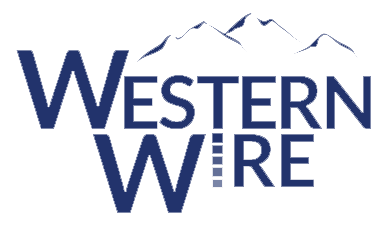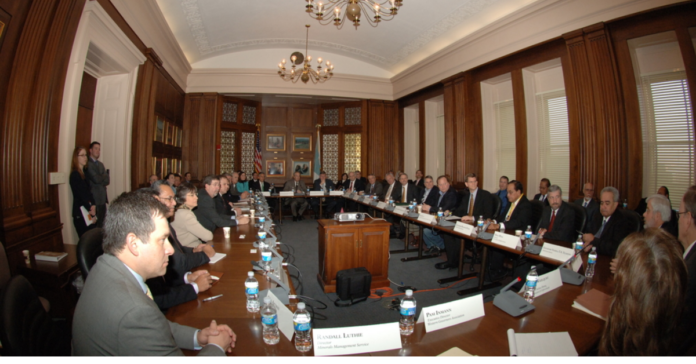The head of the Department of Interior said Monday that relocating the headquarters of the Bureau of Land Management and addressing issues at the agency, like oil and gas permitting and consultation with Native American tribes is an ongoing and important part of a larger reorganization process designed to make the federal government more responsive to stakeholders and residents, particularly in the west.
Following a keynote address to the Western Governors’ Association annual meeting in Vail, Colo., Interior Secretary David Bernhardt sat down with Western Wire staff to discuss the possible relocation of BLM headquarters or significant numbers of staff to a western state, along with oil and gas permitting issues, including sensitivities around cultural heritage areas such as Chaco Culture National Historic Park in New Mexico.
The first in a two-part series.
BLM Reorganization and HQ Relocation
Bernhardt told Western Wire that reporting from last week that appeared to indicate that Colorado Gov. Jared Polis’ assertion that Denver was “more likely” to land the relocated BLM staff and infrastructure than other candidates, like Grand Junction, was an oversimplification of a process the Interior Department, and the secretary in particular, was still conducting.
“I do not think they [Denver] have a leg up, but here is the process we are going through,” Bernhardt said. “Basically, I’m asking a few questions. One, is this a necessary job, do we even need to really do this? Two, if it is a job that should be done, where is the best place on the planet to put it?”
Before the House Natural Resources Committee in May, Bernhardt said the BLM move was “going to happen” and that he was “very committed to working to achieve that.”
But, Bernhardt added, location itself is not the only factor up for consideration—the primary focus is assuring that that any move or reorganization plan will help make the agency more responsive to the American people.
“A re-organization is not about where you are putting something, it is about how will these changes be better for the American people. My view is that I have to be able to confidently answer how these changes will make for a better organization.
At the end of the day, the question is, what is the optimal way to run the BLM in a way that serves the American people. You can look at the facts and come to different conclusions,” Bernhard said.
Bernhardt’s predecessor, former Interior Secretary Ryan Zinke, had emphasized cost-of-living and quality of life as necessary precursors for BLM consideration.
Bernhardt pointed to the three-pronged approach he inherited at Interior after succeeding Zinke earlier this year, a large portion of which the department has already accomplished.
“[Zinke’s] re-org has three major components: 1) Reorganize the geographic boundaries of our regional divisions across the department, except for Bureau of Indian affairs and Bureau of Indian Education. And we did that, in August of last year, the regions were aligned. We are working now to implement that regional change,” Bernhardt said.
“That was designed to get folks at the senior level focused about our mission,” he added, saying that alignment within the department was critical for implementing policy and for completing the tasks involved throughout the reorganization process.
The second part, Bernhardt said, was empowering departmental and agency employees to be more responsive to the people they serve: average Americans accessing National Parks, accessing their mineral rights, or accessing public lands for recreational activities—among many, many other activities.
“How do we delegate more responsibility down, how do we maximize our service to the American people, and how do we put folks closer to what they regulate?” Bernhard said. That included the third aspect of Zinke’s approach—and every Interior Secretary, according to Bernhardt—in reaching a level of management that is responsive within the department to the folks they serve but also to the overall policy set by the administration.
Bernhardt did not agree with a “regional commander” approach that Zinke favored, but still said the struggle for all past secretaries and future ones would be ensuring “how do I as secretary make sure that my vision is being carried out in each of these regions?” he asked. “And every secretary, probably, has struggles with trying to figure that out. I am not a big proponent of we need one-hundred more people at the table to make decisions,” he added.
Speaking before twelve Governors at the three-day event at the Hotel Talisa in Vail, Bernhardt’s opening keynote instead became a question-and-answer session.
The twelve Western Governors included WGA Chair David Ige (Hawai’i), WGA Vice Chair Doug Burgum (North Dakota), Jared Polis (Colorado), Lourdes Leon Guerrero (Guam), Brad Little (Idaho), Laura Kelly (Kansas), Steve Sisolak (Nevada), Michelle Lujan Grisham (New Mexico), Kate Brown (Oregon), Kristi Noem (South Dakota), Gary Herbert (Utah) and Mark Gordon (Wyoming).
“At the Department of the Interior, we fundamentally believe in a vision of shared conservation stewardship with the governors,” Bernhardt said. “My view is that we are trying very hard to work with, not against, the states as it lines up to things like wildlife management, where they [states] have a major role,” he continued. “The wildlife don’t know the difference between state and private land,” Bernhardt said.
Of concern to the governors and a cornerstone to the reorganization process is the allocation of resources and personnel, Bernhardt said.
Regions that were quiet a decade ago, like southeastern New Mexico’s Permian Basin, are suddenly “hot” and require enormous resources for permitting, inspections, and other activities.
“I feel very strongly about delegating accountability and resources to the field more. In doing that, we can put those resources at the front lines of our offices,” he said, rather than being centralized and unresponsive. “Some of our offices are stretched at times because areas heat up in different ways,” he said.
BLM Permitting
Bernhardt turned to oil and gas permitting and quarterly lease sales at BLM, two areas that Zinke championed in his first year at Interior in 2017, and that have remained top priorities at the agency.
“So, let me tell you from my perspective. Last year, we had, first off, there is a theory that way too much land is leased. That’s false.
If anyone looks at our leases, our acres leased today for oil and gas are lower than they they’ve been in a really long time. Does that surprise you given the rhetoric?” Bernhardt said, pointing to the announcement in May that showed an increase in revenues and production while using far less acreage under lease since records began in 1985.
“At the same time, our production numbers are really extraordinary. So, what does that say? With technology improvements and other things, we’re getting more energy produced even though there are fewer acres leased.
That doesn’t mean we shouldn’t lease or anything like that but it’s a really interesting dynamic,” Bernhardt explained.
Part of the increase, he said, was rapidly decreasing the amount of time it took to process applications for permits to drill (APDs).
“Our APD processing time is substantially down. Our revenues are substantially up. If you look at the number of wells spudded in Colorado in 2016 versus 2018, it’s like 111 to 225,” Bernhardt said.
Record revenues from leasing has driven hundreds of millions of dollars to the states, who share a roughly equal amount with the federal government based on parcel acreage of BLM lands auctioned off within their boundaries.
New Mexico has received the lion’s share of those proceeds, claiming nearly half a billion dollars from the 3rd quarter sale in 2018, and more than $1 billion overall from BLM sales for the whole year.
Permitting in the west does have additional factors, such as cultural and ancient sites that require additional attention and scrutiny, Bernhardt said, as well as the mineral rights of some Native Americans, such as Navajo allottees.
“Cultural issues are certainly issues that need to be contemplated as we go through our planning processes,” Bernhardt said. Some areas in the San Juan Basin in New Mexico pose challenges due to the nature of the historical and cultural connections with the nearby residents and descendants of the region.
“Chaco is a little different than that. These are big, big structures. So, my view on it is that the governor [Michelle Lujan Grisham] has a strong view, the senators [Tom Udall, Martin Heinrich] have a strong view, and we’re in the middle of a planning process and there is legislation on the hill that they think will pass,” Bernhardt said, pointing to S. 1079, co-sponsored by both of New Mexico’s U.S. Senators.
“And truthfully, for many years, there has not been leasing, new leasing in this ten-mile area,” he added, acknowledging that the one-year-delay would allow for additional time to let other avenues, like legislation, progress and possibly give his department a new mandate. “And I thought that was appropriate in that particular instance.
But the reality, we’re moving forward pretty aggressively on ensuring there is access to federal land grant development and will continue to do that appropriately,” Bernhardt said.
The key, Bernhardt said, was to be responsive to concerns and flexible in addressing them, through additional consultation and developing draft resource management plan benchmarks.
The goal of achieving priorities of energy independence weren’t thwarted by being thoughtful and responsive in every instance, he added.
“But that doesn’t mean that there is never an instance where ‘hey, we need to think about this a little more or differently.’ I think that comes with being reasonable,” Bernhardt said.
Bernhardt also addressed the increase in protests of BLM parcels.
“You’ll see a trend line of protests that were 20 percent, then they went to 30, then they went to 35, then they went to 37. And then [former Interior Secretary] Ken Salazar came in and said, ‘they’re going to go down.’ And when [Interior Secretary Sally] Jewell left, they were actually higher than when [former President George W.] Bush left.
And now they’re kind of off-the-chart,” he said. But they are also a necessary part of the process, he insisted. “So, protests are a legal avenue that people have, and a legal avenue people pursue,” he concluded.

